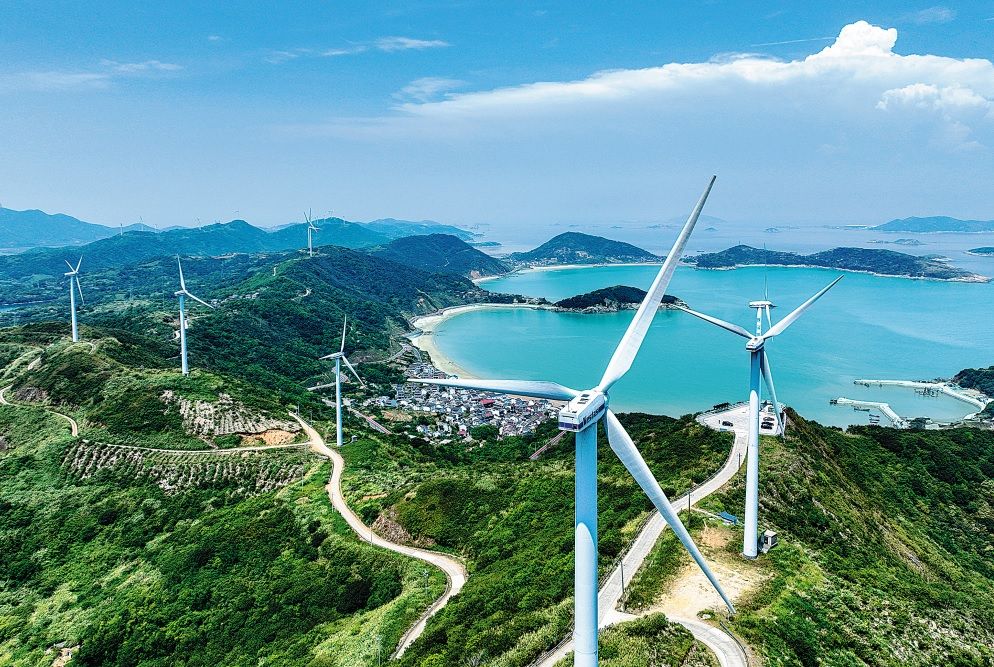
From the shimmering solar panels carpeting the desert to hydrogen-producing facilities humming in inland industrial bases and giant wind turbines lining the coasts, China's green transition is leaving its mark across the country.
Guided by Xi Jinping Thought on Ecological Civilization, the nation has steadfastly implemented a series of institutional mechanisms for promoting low-carbon transition, paving the way for a green, sustainable future.
Experts said they believe that the world's second-largest economy will continue to etch more green imprints on its vast territory, as the country advances reforms to promote ecological civilization.
Their confidence comes as China gears up for its second National Ecology Day, which falls on Thursday and has the theme "Accelerating Green Transition in all Areas of Economic and Social Development".
Ecological civilization is a concept promoted by President Xi Jinping for balanced and sustainable development that features harmonious coexistence between mankind and nature.
One of the 10 tenets of Xi Jinping Thought on Ecological Civilization is that green development is a profound revolution in the concept of development.
Xi, who is also general secretary of the Communist Party of China Central Committee and chairman of the Central Military Commission, has attached great importance to the green and low-carbon transition.
When addressing the National Conference on Ecological and Environmental Protection in July last year, Xi emphasized that China should accelerate the green and low-carbon transformation of its development models, maintain green and low-carbon development as the fundamental solution to ecological and environmental issues, accelerate the formation of green production modes and lifestyles, and lay a green foundation for high-quality development.
As part of that effort, an 18-megawatt, semi-direct drive offshore wind turbine was successfully installed in early June at a coastal test base in Shantou, Guangdong province.
With a rotor diameter of 260 meters, it is the world's largest installed offshore wind turbine, according to its developer, Dongfang Electric Corp. Its swept area is more than 53,000 square meters, equivalent to 7.4 soccer fields.
It can generate up to 72 million kilowatt hours of electricity a year, which is enough to meet the annual electricity demand of about 36,000 households, while saving more than 22,000 metric tons of standard coal and reducing carbon dioxide emissions by more than 59,000 tons.
The giant wind turbine is seen as a microcosm of China's success in positioning itself as a renewable energy leader around the globe in just four decades.
Data from the National Energy Administration shows that China contributed over 50 percent of the world's 510 gigawatts of newly installed renewable energy capacity in 2023. The country also holds a dominant position in the production of photovoltaic components, wind turbines and batteries.
China's installed capacity of renewable energy hit 1.32 billion kW by the end of June 2023, exceeding that for coal-fired power, the administration said.
Ma Jun, director of the Beijing-based Institute of Public and Environmental Affairs, said that China managed to make such significant progress thanks to a series of forward-looking policies for renewable energy development, guided byXi Jinping Thought on Ecological Civilization.
"These forward-looking policies have attracted a large amount of investment into the renewable energy sector, and then triggered intense market competition and also rapid innovation," Ma said.
For example, China introduced the subsidized price for renewable energy, or feed-in tariff, in 2006.The feed-in tariff — a surcharge on electricity bills — guaranteed solar and wind companies above-market prices for their energy.
After six adjustments to the subsidies for wind power and eight for solar photovoltaic power, the on-grid power tariffs of these two types of renewable energy have now equaled those of coal-fired power.
Even greener future
With more new mechanisms being implemented as reforms for promoting ecological civilization continue, the country is going to embrace an even greener future, experts said.
Wang Jinnan, an academician at the Chinese Academy of Engineering, has highlighted the potential role of a recently implemented, area-specific environmental management mechanism in securing more low-carbon development.
In March, the general offices of the Communist Party of China Central Committee and the State Council jointly released guidelines on a more area-specific approach to environmental management.
By 2025, the system for area-specific environmental management should be essentially established, and the system will be full-fledged and functioning efficiently by 2035, according to the guidelines.
Wang, who is also former president of the Chinese Academy of Environmental Planning, pointed to the country's previous functional zoning strategy as one that established an overarching pattern for development and protection in different regions.
Targeting much smaller areas, the area-specific environmental management mechanism is expected to provide better support for the country's green and low-carbon transition, he said.
Under the mechanism, more than 40,000 grids for ecological and environmental management have been set up across the country. Each of the grids has a tailored, specific blacklist for project introduction, he said.
Ma, the Institute of Public and Environmental Affairs director, said that with these grids and their blacklists, China has put into practice what is merely at the conceptual level in many other countries.
More reforms concerning green transition are on the way, as demonstrated by the resolution adopted by the third plenary session of the 20th CPC Central Committee in July.
The resolution highlighted the importance of focusing on building a beautiful China and promoting harmonious coexistence between mankind and nature as a key aspect of the overall goal of further deepening reform, said Sun Jinlong, Party chief of the Ministry of Ecology and Environment.
China's economic and social development has entered a stage of high-quality development that features an even more green and low-carbon trend, but balancing high-quality development and high-level protection remains a daunting task, he said.
"Deepening ecological civilization reform and resolutely eliminating institutional mechanisms that hinder high-level protection and high-quality development will facilitate the green and low-carbon transition of development models," Sun said, adding that this "will cultivate green productivity with high-level protection and support high-quality development".
编辑:齐悦